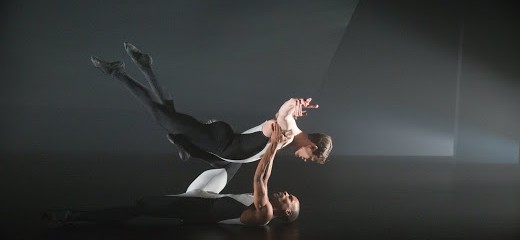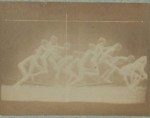
Ballet Beasts: Animals All
by Lynn Matluck Brooks
Nature or nurture—which most powerfully determines human behavior? This “sociological debate,” as Artistic Director Christine Cox puts it in her program note, is the subject of BalletX’s fall premiere, Nicolo Fonte’s Beasts.Fonte’s answer is clear: our movement, our mating, our social veneer, and our violence barely sheathe our inner beastliness. In the course of the performance, the acrobatic and committed dancers in this season’s company reveled in their inner beasts, even as the discipline of refined ballet technique hoisted them to heights of movement expression that few humans, let alone any other species, could master.
The evening-length work, presented in two acts, opens with stunning lighting (by Drew Billiau) piercing the mist of the stage as dancers emerge from beneath a tilted upstage scrim (set by Mimi Lien). This opening scene is gripping, as each creeper-crawler that appears before us seems to come out of nowhere, hazily taking form and joining the growing colony of creatures inhabiting the stage. The tilted scrim hovers over this act like a cave beneath which the dancers wriggle, writhe, press, and pop themselves toward verticality—head, tail, paw, shoulder. With their personal struggles to rise, they struggle also to dominate one another, push one aside, claim another’s territory, survive and thrive. When they finally achieve bipedal balance, they still hulk, sometimes with turned-in hips and feet, struggling for articulation.
Sex helps that next evolutionary step. In their drive to find and mate with one another, they discover that feet can tap, fingers can stroke, hips can pump, faces can tell stories. From the atmospheric music of German composer Henrik Schwarz, the beasts move to the suave humor of Ella Fitzgerald singing "Let’s Do It, Let’s Fall in Love." But the sex turns ugly: one woman’s male attacker leaves her dead, and abandons her in the field. Another man (perhaps a shaman? – danced by Gary W. Jeter II) takes the stage to revive her. Not only her own now-enlivened self but the cast as a whole appears to close out the first act in a rhythmic celebration of life.
In the second act, we are deep into human society—in an elegant ballroom, no less, with tuxedoed swains whirling their pointe-shoed ladies in a waltz. Even so, the occasional critter-like wriggle, paw, or stretch reveals the animal within each polished cavalier. The social veneer is thin, indeed: the women nearly strangle their partners before they are escorted off the stage, leaving the five men to a Wild West, or Mafioso, shoot-out, still hungry to dominate, eliminate, obliterate. Not only the men are bloodthirsty: a dominatrix (Chloe Felesina) in a blood-red gown appears to take them all on, knocking them off one after another like a viper systematically poisoning her prey.
But Fonte’s men also have a softer side. One of them (Richard Villaverde) returns, bare-chested, in a black-feathered tutu, recalling with apparent agony the Dying Swan’s death throes. A white swan follows him, partnered by two cavaliers who hoist and toss her, the black swan fellow looking on longingly. Jazzy music saves the scene, once again, as the full cast enter one at a time, several in gender-crossing costumes (gals in tuxedo jackets, vests, or ties; guys in skirts of various sorts). Friendlier, more welcoming to one another, they skitter at times along the floor, recalling their animal selves: now tolerant, communal animals all.
With the final musical selection, Claude Debussy’s Claire de lune, the dancers gather upstage center, hold hands, slowly circling one another as they strip down to trunks or body suits. Spreading out across the stage, the ten dancers walk toward the audience, smile sweetly to us, then gesture warmly toward one another, inviting us to applaud them. We do: the packed house rises in a standing ovation.
BalletX has built a devoted, wide-ranging audience that packs the house, even on weeknights. With Fonte’s Beasts, the company delivered what this audience wanted: high-powered physicality and themes au courant. Will the work become a dance classic? Its references—guns, sexual assault, graphic (if lighthearted) sex play, gender-bending—root it to its time. I wonder, though, if this investigation of the animal beneath our social skin is enduring enough to transcend its moment. That, of course, only time’s passage can reveal.
BalletX, Wilma Theater, Nov. 18-22
By Lynn Matluck Brooks
November 22, 2015






.png)


